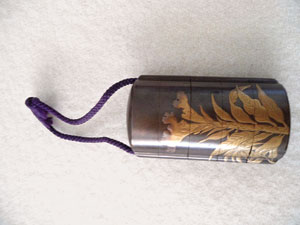 Nina sent me a funny little box her parents acquired when they lived in Japan before World War II. Nina said people used it to carry medicine, but she’s only half right. I see the original use reflected in the Japanese name, “inro,” which means “seal box.” Seals are of utmost importance to East Asian culture. In fact, “in” means the imprint made by the seal in Japanese, an imprint sometimes made by a stamp of stone, metal, bamboo, ivory or, today, plastic.
Nina sent me a funny little box her parents acquired when they lived in Japan before World War II. Nina said people used it to carry medicine, but she’s only half right. I see the original use reflected in the Japanese name, “inro,” which means “seal box.” Seals are of utmost importance to East Asian culture. In fact, “in” means the imprint made by the seal in Japanese, an imprint sometimes made by a stamp of stone, metal, bamboo, ivory or, today, plastic.
East Asians use seals today for many occasions.
Originating in the third century BCE, a few reasons to use this stamp include:
- your name
- your nickname
- a line of poetry, greeting, good luck or get well wish
- and more
A seal might incorporate ideograms, characters, or images, much as we use emojis today. One sees family seals, banking seals, official seals, the seal of the realm, the seal of your office, and the seal of an entire county. Important seals remain locked away and accessed only by a VIP. Some people set them in beautiful stampers, carved and inlaid, and displayed in state.
A gentleman carried a portable box to hold four or more essential seals. That’s what Nina showed me, the inro box, which hung from a man’s waist cord. On Nina’s box we see a cord that runs around three sides of the box. A gent loosened the cord’s tension to get in any of the four stackable sections, then pulled them tight again with a bead that joined the cord at the top. The cord lies underneath the gentleman’s obi, or sash, anchored by a decorative toggle at the other end of the long cord called a netsuke. I find Netsukes highly whimsical and collectible, often carved in a figure from nature in ivory, a subject for another article.
What’s the intricate decoration of this inro?
This is Japanese lacquer, collected as a milky sap from sumac trees, poison ivy and poison oak, mango or cashew trees. Raw lacquer irritates skin so artisans developed a tolerance over time. It cures only under high humidity.
The inro is a special type of lacquer design, overlaid on wood box shapes, up to hundreds of layers. The gold design of a stylized iris is a layering of gold lacquer in stages, creating a gold lacquer relief. This technique is called hiramaki-e, a low flat relief (raised design). The black color comes from iron oxide used as pigment. It amazes me about these ancient techniques that somebody discovered how to milk, reduce, and create such beauty from poison oak. Notably, the iris symbolized a warrior spirit and protection from evil spirits, especially on the fifth day of the month, and was the symbol of “blue blood,” the heroic and faithful male – we see them in the spring for the Japanese “Boys Day” every May 5.
Nina’s inro dates from 1875 and is worth $2,000. Nice little four inch piece of history, Nina!